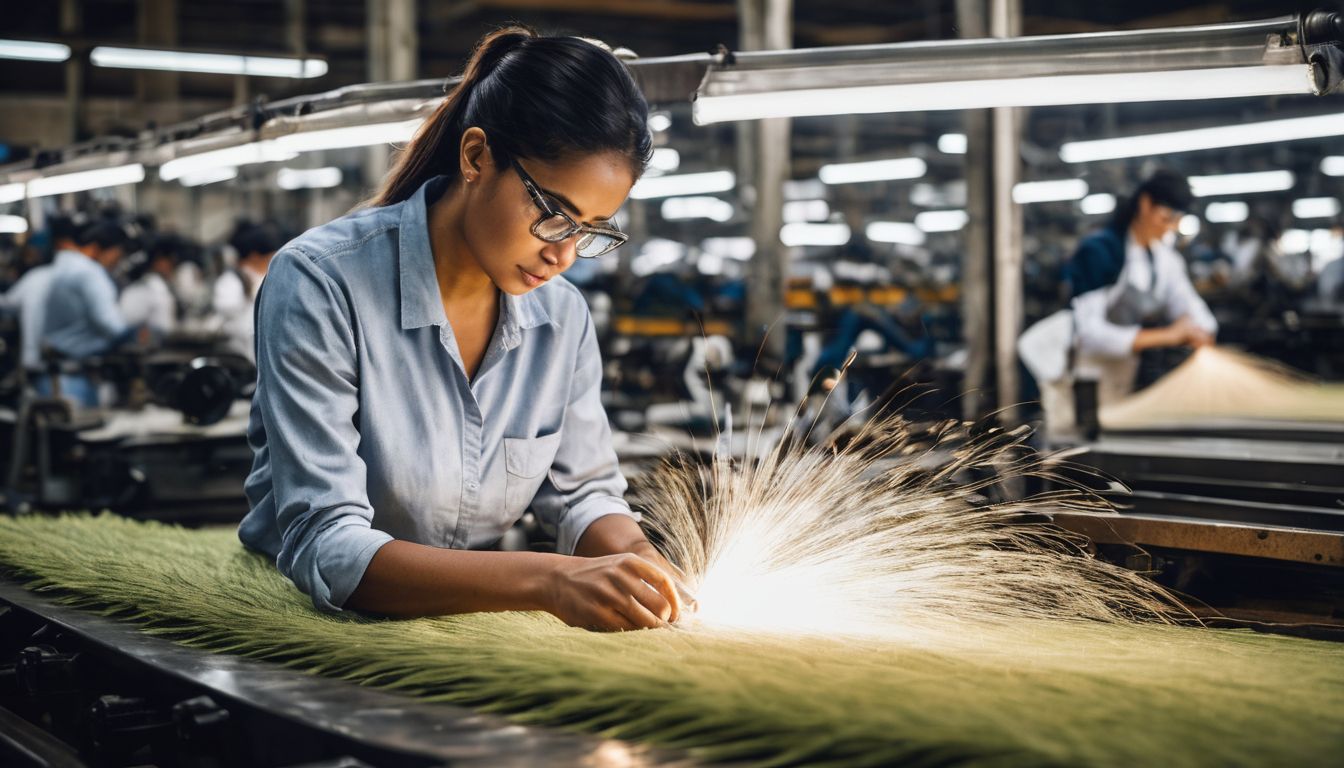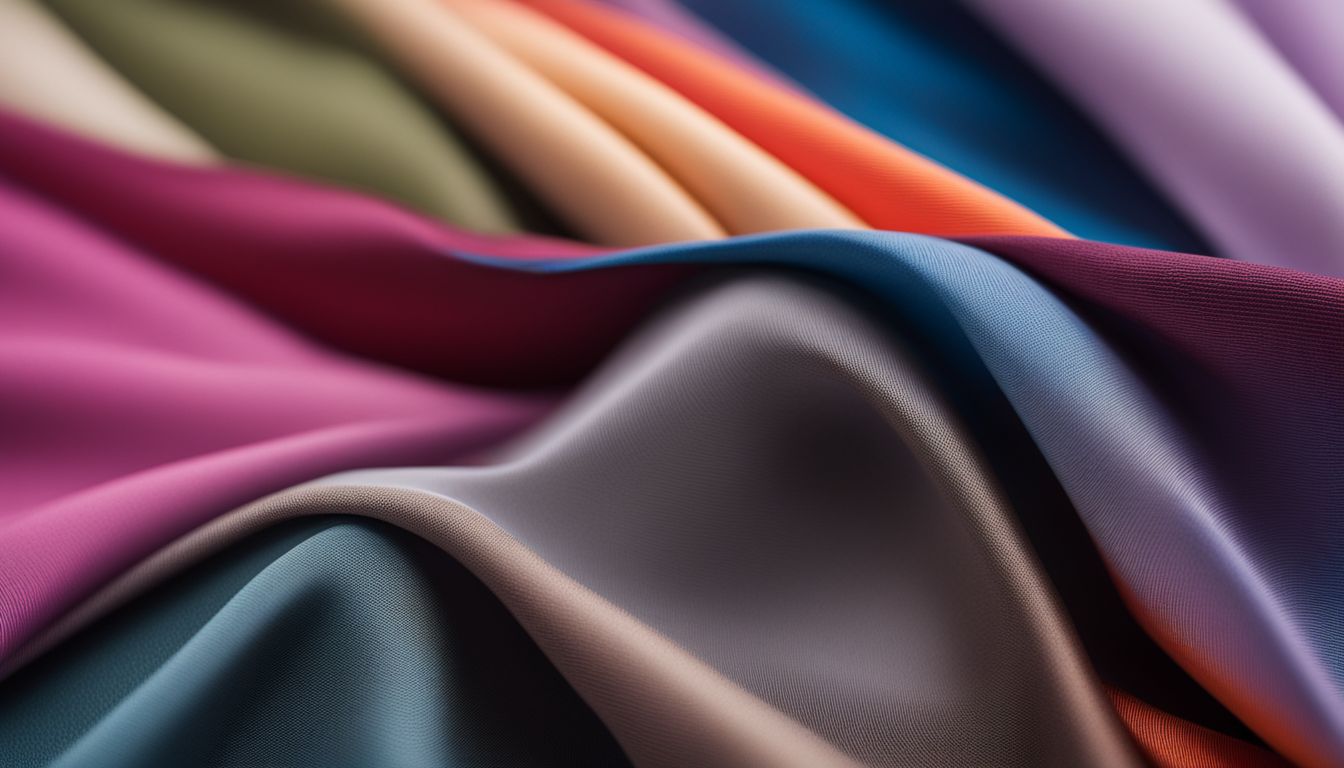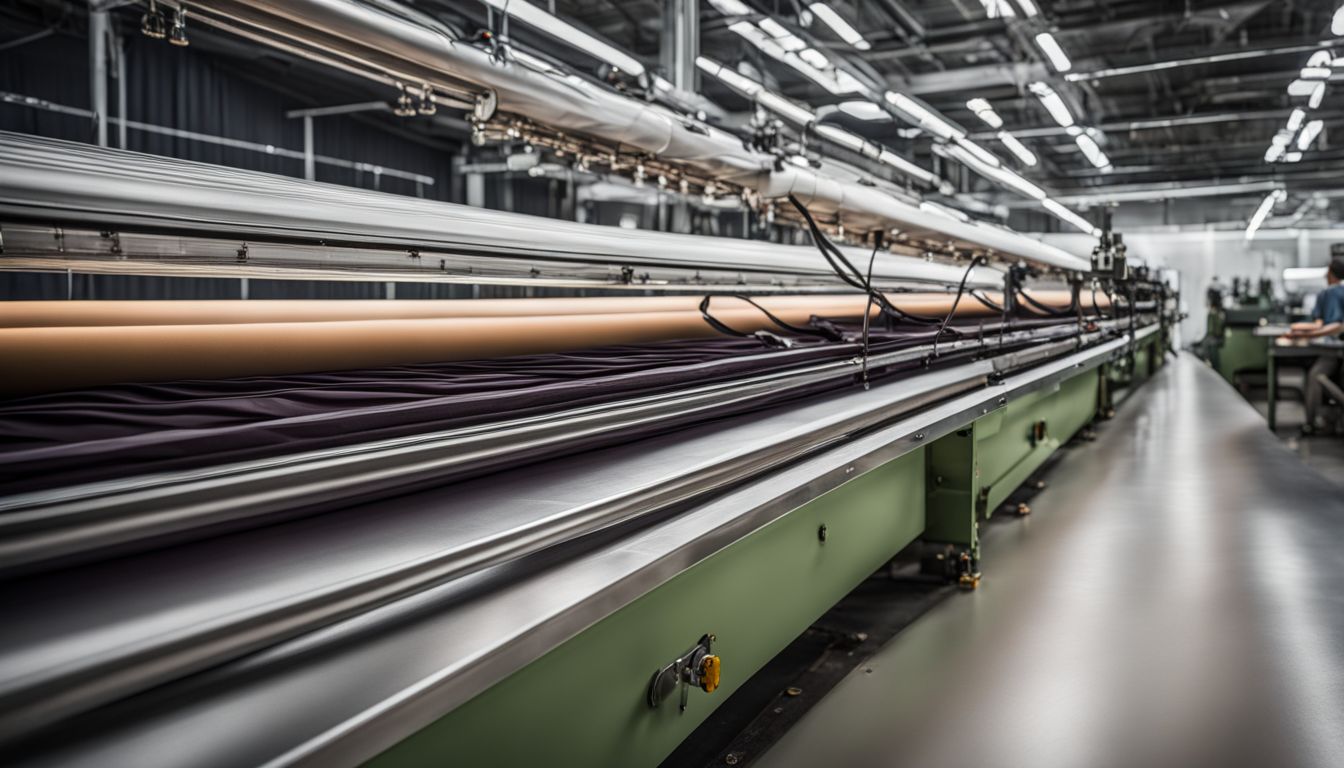Modal Fabric: Understanding It’s Production Process, Properties & Sustainability?
Are you on the hunt for a sustainable fabric that doesn’t compromise on comfort or durability? Modal fabric, a semi-synthetic material derived from beech trees, might just be your perfect match.
This blog will unravel the mystique around modal fabric – its production process, properties and most importantly, its sustainability quotient. Don’t miss out as we delve into whether this eco-friendly contender truly lives up to all its hype!
Stay tuned if you’re interested to learn more about this extraordinary material in the world of fashion.
Key Takeaways
- Modal fabric is a sustainable and eco – friendly option in the world of fashion, made from beechwood trees through a specialized manufacturing process.
- Compared to other semi – synthetic cellulosic fibers like viscose and lyocell, modal fabric stands out for its stretchiness, durability, breathability, and biodegradability. It is widely used in clothing, bedding, and other textile products.
- Although modal production requires the use of chemicals and involves cutting down trees, recent innovations have aimed to make it more sustainable by implementing closed-loop systems, recycling harmful chemicals, using eco-friendly dyes and finishes, and sourcing wood from sustainably managed forests.
What is Modal Fabric and How is it Made?

Modal fabric is a type of semi-synthetic cellulosic fiber that is made from beechwood trees through a specialized manufacturing process.
Manufacturing process of modal fabric
Making modal fabric needs many steps. First, beechwood trees are cut down to get wood pulp. This pulp is then turned into cellulose. After that, the cellulose goes in a bath of chemicals to form a sticky substance. The substance is pushed through little holes to make long fibers.

These fibers are then spun into yarn and woven into fabric. Modal fabric is light and soft but also very strong. This process takes time and costs more than making other fabrics like polyester. It also uses less water and fewer harmful chemicals than cotton does. But, it still harms forests because trees need to be cut down for it.
Properties of modal fabric

Modal fabric feels soft and smooth. It’s more long-lasting than cotton. This fabric is stretchy so it doesn’t lose its shape over time. You can wash modal many times without it wearing out or shrinking much.
Modal lets air pass through, making it a breathable fabric. Plus, it absorbs water well, drying faster compared to other fabrics. Being made from beech trees gives modal fabric a natural shine, similar to silk but not as shiny.
Sustainability of Modal Fabric

Modal fabric raises concerns about its sustainability due to its impact on the environment, use of chemicals, and potential destruction of forests.
Comparison to other semi-synthetic cellulosic fibers

Modal fabric holds a distinctive place in the realm of semi-synthetic cellulosic fibers due to its unique properties.
| Semi-synthetic Cellulosic Fibers | Properties | Uses |
|---|---|---|
| Modal | Modal is known for its stretchiness, durability, breathability, and biodegradability. It’s also more expensive than many other fibers. | Modal is widely used in the fashion industry for clothing, bedding, and other textile products. |
| Viscose (Rayon) | Viscose fabric shares many of the same properties as modal. However, its manufacturing process is less sustainable, and it’s not as durable. | Viscose is used in a variety of products, from clothing to upholstery and carpets. |
| Lyocell | Lyocell is highly absorbent, durable, and wrinkle-resistant. It’s also more environmentally friendly than viscose, as its production process is more sustainable. | Lyocell is commonly used in clothing, linens, and medical dressings. |
| Cotton | Cotton is a natural fiber known for its comfort and durability. However, it requires a significant amount of water and pesticides to grow, limiting its environmental friendliness. | Cotton is used in a wide array of products, from clothing and bedding to towels and rugs. |
The Environmental Impact of Modal Fabric
Modal fabric has raised concerns due to its environmental impact, including forest destruction and the use of harmful chemicals in its manufacturing process. However, recent innovations have shown potential for more sustainable practices in modal production.
Forest destruction
Modal fabric is made using cellulose extracted from beechwood trees. While this process is resource-intensive, it does not directly contribute to deforestation or forest destruction.
The trees used for modal production are grown sustainably in certified forests, ensuring responsible sourcing practices. Moreover, the biodegradable nature of modal fabric means that it breaks down naturally and does not add to environmental waste.
By choosing modal fabric, you can support sustainable forestry practices while enjoying the benefits of a silky-smooth and lightweight textile.
Use of harmful chemicals

Modal fabric is made using a complex chemical process that involves the use of harmful chemicals. These chemicals are used to break down the beechwood trees and extract cellulose, which is then spun into fibers to create the fabric.
The production of modal fabric requires the use of toxic substances such as carbon disulfide and caustic soda. However, recent innovations in modal production have aimed to reduce the environmental impact by implementing closed-loop systems and recycling these harmful chemicals.
While efforts are being made to make modal production more sustainable, it is important to be aware of the potential negative effects associated with the use of harmful chemicals in its manufacturing process.
Potential for more sustainable practices

Modal fabric already has a reputation for being one of the more sustainable fabrics available, but there is still potential for even more environmentally friendly practices in its production.
Manufacturers are continually working on reducing their environmental impact by implementing measures such as using eco-friendly dyes and chemicals and optimizing water and energy usage.
Additionally, there have been recent innovations in modal production that aim to make it an even greener alternative. These advancements include closed-loop production systems that recycle solvents and waste materials, as well as sourcing beechwood from certified sustainably managed forests.
Recent innovations in modal production

Modal fabric production has seen recent innovations that aim to make the process more sustainable. One such innovation is the use of closed-loop systems, where chemicals used in the manufacturing process are captured and recycled instead of being released into the environment.
This helps reduce pollution and minimize waste. Another innovation involves using eco-friendly dyes and finishes that are less harmful to both human health and the environment. These advancements in modal production contribute to making this fabric even more environmentally friendly and sustainable.
Modal Fabric vs. Other Fabrics

Modal fabric offers several benefits compared to other fabrics, including its soft and silk-like texture, lightweight feel, breathability, and durability. To learn more about how modal fabric compares to cotton, viscose, and lyocell, continue reading.
Comparison to cotton, viscose, and lyocell
Modal fabric has several advantages when compared to cotton, viscose, and lyocell. Unlike cotton, which requires a significant amount of water for cultivation, modal is made from sustainably sourced beechwood trees that require less water and land. Viscose fabric, although similar in manufacturing process to modal, often involves the use of harmful chemicals like sulfuric acid. Lyocell is another sustainable fabric option but can be more expensive than modal. Modal fabric offers a great combination of softness, breathability, and durability while being an environmentally friendly choice.
Benefits and drawbacks of modal fabric
Modal fabric offers several benefits that make it an attractive choice for clothing and other textiles:
- It is known for its silk – like texture, making it soft and smooth to the touch.
- Modal fabric is lightweight, which makes it comfortable to wear, especially in warmer climates.
- It has good breathability, allowing air to circulate through the fabric and keeping the wearer cool.
- Modal fabric is highly absorbent, meaning it can wick moisture away from the body, helping to keep the skin dry.
- It is stretchy and resistant to creasing, making it a durable choice that maintains its shape well over time.
- Modal fabric has good color retention properties, so garments made with modal tend to retain their vibrant colors even after multiple washes.
- Modal fabric requires special care when washing and ironing. It is recommended to follow the care instructions provided by the manufacturer to ensure longevity.
- Modal fabric may not be as widely available as other fabrics like cotton or polyester, which can limit options for consumers.
- The production process of modal fabric involves chemical processing and can have environmental implications if not done sustainably. However, recent innovations in modal production aim to reduce these impacts.
Caring for Modal Fabric
Modal fabric is easy to care for, requiring gentle machine washing and low heat ironing. Its durability ensures long-lasting clothing that maintains its softness and comfort. Discover how you can easily incorporate modal fabric into your wardrobe with these simple care instructions.
Washing and ironing recommendations

Modal fabric is easy to care for and requires minimal effort to keep it looking its best. Here are some washing and ironing recommendations for modal fabric:
- Machine wash: Modal fabric can be machine washed in cold or warm water. Use a gentle cycle to avoid damage.
- Mild detergent: Use a mild detergent that is suitable for delicate fabrics. Avoid using harsh chemicals that can degrade the fabric over time.
- Avoid bleach: Do not use bleach on modal fabric, as it can weaken the fibers and cause discoloration.
- Hang dry: After washing, air dry your modal clothing by hanging them up to dry. This will help retain their shape and prevent shrinking.
- Iron on low heat: If you need to remove wrinkles from your modal clothing, use a low heat setting on your iron. Avoid high heat, as it can scorch or melt the fabric.
- Steam ironing: Alternatively, you can use a steamer to remove wrinkles from modal fabric without direct contact with the iron.
- Store properly: When not in use, fold your modal clothing neatly and store them in a cool, dry place away from direct sunlight to prevent fading.
Durability and longevity of modal clothing

Modal clothing is known for its durability and longevity. This means that it can withstand regular wear and washing without losing its quality or shape. Modal fabric has strong fibers that make it resistant to pilling, fading, and stretching.
It also retains its softness even after multiple washes. So, you can enjoy wearing your modal clothing for a long time without worrying about it wearing out quickly. With proper care, modal garments can last for years, making them a sustainable choice in the fashion industry.
Sustainable Brands Using Modal Fabric

Many ethical and sustainable brands have embraced modal fabric for its eco-friendly qualities. Discover how these brands are using modal to create stylish and sustainable clothing.
Read more about it!
Examples of ethical and sustainable brands utilizing modal fabric

- Patagonia: This outdoor clothing brand uses modal fabric in many of its products, ensuring they are both eco-friendly and durable.
- Eileen Fisher: Known for their commitment to sustainability, Eileen Fisher incorporates modal fabric into their designs, offering customers comfortable and ethical clothing options.
- Amour Vert: This fashion brand focuses on using sustainable materials, including modal fabric, to create stylish and environmentally conscious clothing choices.
- People Tree: A pioneer in the world of sustainable fashion, People Tree uses modal fabric in their collections, promoting fair trade practices and organic textiles.
- Reformation: With a mission to create fashion that doesn’t harm the environment, Reformation incorporates modal fabric into their designs, offering chic and sustainable clothing options.
Conclusion

In conclusion, modal fabric is indeed a sustainable choice for those who prioritize environmental friendliness. It is made from plant-based materials and goes through a chemical process to create a biodegradable fabric.
Modal offers benefits such as durability, breathability, and a smooth texture. Although it may be slightly more expensive than synthetic fabrics, its positive impact on the environment makes it worth considering when making conscious choices about clothing and textiles.
FAQs
1. What is modal fabric made from?
Modal fabric is made from beech tree pulp, which is processed into a soft and breathable textile.
2. Is modal fabric eco-friendly?
Yes, modal fabric is considered to be more sustainable than many other fabrics because it comes from renewable resources and requires less water and land compared to cotton production.
3. Is modal fabric suitable for sensitive skin?
Yes, modal fabric is known for its hypoallergenic properties, making it suitable for people with sensitive skin as it is soft, gentle, and less likely to cause irritation.
4. How do I care for garments made of modal fabric?
To care for garments made of modal fabric, it’s best to follow the care instructions on the label. Generally, machine washing on a gentle cycle with cold water and using a mild detergent will help maintain the quality of the garment over time.







